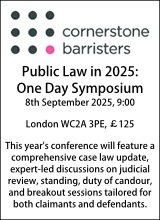
The final say
News
Must read
Families refusing access to support
Features

Producing robust capacity assessments and the approaches to assessing capacity

Disability discrimination and proportionality in housing management

Cross-border deprivation of liberty

Dealing with unexplained deaths and inquests

Court of Protection case update: May 2025
Sponsored articles
What is the role of the National Trading Standards Estate & Letting Agency Team in assisting enforcement authorities?
Webinars
Is Omeprazole the new EDS?
More features
Provision of same-sex intimate care
Court of Protection case update: April 2025
High Court guidance on Article 3 engagement in care at home cases
‘Stitch’, capacity and complexity
Issuing proceedings in best interests cases
Court of Protection case law update: March 2025
The Health and Social Care (Wales) Bill Series – Regulation and Inspection of Social Care
The Health and Social Care (Wales) Bill Series – Direct Payments for NHS Continuing Healthcare
What is the right approach to Care Act assessments?
Disabled people in immigration bail: the duties of the Home Office and local authorities
Capacity, insight and professional cultures
Court of Protection update: February 2025
Setting care home fees
Could this be the end for local authority-provided residential care?
“On a DoLS”
It’s all about the care plan
Court of Protection case update: January 2025
Mental capacity and expert evidence
Best interests, wishes and feelings
Capacity, sexual relations and public protection – another go-round before the Court of Appeal
Court of Protection Update - December 2024
Fluctuating capacity, the “longitudinal approach” and practical dilemmas
Capacity and civil proceedings
Recovering adult social care charges via insolvency administration orders
Court of Protection case update: October 2024
Communication with protected parties in legal proceedings
The way forward for CQC – something old, something new….
The Ombudsman, DoLS and triaging – asking the impossible?
Outsourcing and the Human Rights Act 1998 – the consequences
Commissioning care and support in Wales: new code of practice
Release date
- Details
Can release from hospital be a deprivation of liberty? Matthew Flinn examines an important ruling in the Upper Tribunal.
In Secretary of State for Justice v RB [2010] UKUT 454, the Upper Tribunal has departed from a line of court authority to decide that where a patient has been detained under the Mental Health Act 1983, conditionally discharging that patient from hospital subject to conditions which might themselves amount to a form of detention is compatible with Article 5 of the European Convention of Human Rights, the right to liberty .
RB, who was aged 75, had been detained under the Mental Health Act on 30 June 1999 following a conviction for indecent assault on a boy aged under 16. He suffered from a persistent delusional disorder, which rendered him a “strongly misogynistic”, lifelong paedophile.
Following a failed application for discharge from hospital in 2007, on 24 April 2009 the Mental Health Review Tribunal decided that under sections 72 and 73 of the Act, RB could be discharged subject to conditions, including a condition that he reside at a specified care home, and that he did not leave the grounds of that care home except when supervised. If he breached any of these conditions he could be recalled to hospital. RB was keen for the discharge to occur and willing to comply with those conditions.
The Secretary of State sought to oppose the release of RB, and appealed this decision to the Upper Tribunal.
The unusual aspect of the appeal was that the Secretary of State relied in part on Article 5 of the European Convention on Human Rights, which enshrines the right to liberty and freedom from arbitrary detention. He argued that according to authority, a discharge to a care home as ordered in the case of RB, having regard to the conditions imposed upon him, amounted to a continuing deprivation of liberty, and was contrary to Art 5 and ultra vires (outside of his powers).
The upshot of this argument was that the discharge order was unlawful, and RB should have remained detained in hospital. It appears that the Secretary of State was motivated by the view that if a patient is not sufficiently safe to be discharged without restrictive conditions placed upon his movement, he should not be released at all.
The authority relied on by the government included a Court of Appeal decision (R (Secretary of State for the Home Department) v Mental Health Review Tribunal [2002] EWCA Civ 1868 – “the PH case”) and three High Court decisions (R (G) v Mental Health Review Tribunal [2004] EWHC 2193 (Admin), R v Secretary of State for the Home Department) v Mental Health Review Tribunal [2004] EWHC 2194 (Admin) and IT v Secretary of State for the Home Department [2008] EWHC 1707).
The Secretary of State argued that these cases bound the Upper Tribunal to apply the “PH principle”, which provided that the concept of “discharge” under section 73 of the Mental Health Act entailed a release from actual detention, so that when a conditional discharge had such stringent conditions attached that it did not constitute a release from detention, it was unlawful.
The Upper Tribunal declined to follow this line of authority. It said that it was not bound by the Court of Appeal decision in the PH case, since that case had not definitively decided that a discharge required a release from detention (that principle had been addressed in the court below; the CA had simply proceeded on the basis that it was correct). It also said that it was not bound by the more forthright High Court authorities because, pursuant to changes made by the the Tribunals, Courts and Enforcement Act 2007, it was exercising a jurisdiction equivalent to what the High Court had exercised in the past – it was therefore dealing with decisions of a court of co-ordinate jurisdiction, and was not bound to follow its decisions if it considered them to be wrong.
On the substantive issue before it, the view of the Upper Tribunal itself was that the word “discharge” did not necessarily entail a release from detention to a state of liberty. It preferred what it considered to be a more natural approach to the word; it noted that dictionary definitions showed that, depending on context, the word could mean “release from custody”, but could also mean release in the more general sense of “dismiss” or “send away”:
“Thus, in ordinary language, a patient may be ‘discharged’ from hospital, without any connotation that he is being released from the deprivation of liberty in the legal sense. In relation to section 72, it seems more natural to read the word ‘discharge’ as meaning simply release from the state there mentioned, that is from ‘detention in a hospital for treatment’.”
This resulted in a much narrower PH principle: a tribunal could not conditionally discharge a person with conditions that amount to detention in a hospital for treatment. Continuing detention in some other environment, however (or presumably a shift to another hospital under conditions which did not amount to detention), would not be ultra vires or a breach of Article 5.
In reaching this decision, the Upper Tribunal appeared perturbed by the invocation of Article 5 as a means of requiring the continued hospital detention of a patient, rather than facilitating his discharge. In paragraph 52 of its judgment it said: “We agree respectfully…that it is ‘curious’ to find the Secretary of State praying in aid Article 5 of the ECHR to deny the patient a conditional discharge. We note the similar comments of Dr. McKenna, from his ‘perspective as a clinician’, as to the use of the ‘unusual lever’ of cases on human rights to restrict the liberty of a man who ‘has capacity and who consents (enthusiastically) to the proposed transfer’.”
It is perhaps this unease which motivated its reasoning, and its clear desire to avoid following case law which, even if not binding, was to have strong persuasive value. It might be asked why, when the dictionary offers “release from custody” as one of the natural meanings of “discharge”, this was not the most natural interpretation to choose in context.
After all, RB’s detention did amount to a form of custody, and as the Upper Tribunal itself noted, the powers of the Mental Health Review Tribunal to order discharge under sections 72 and 73 of the Mental Health Act 1983 were enacted as a direct result of the Strasbourg decision in X v United Kingdom (1981) 4 EHRR 188, which held in relation to Article 5(4) that compulsorily detained patients were entitled to periodic review of their detention by a court with power to direct, rather than simply to recommend, discharge. They were thus enacted to ensure that a prisoner could challenge their detention; discharge was perceived as a means of securing liberty.
On the other hand, it might be argued that if the government is concerned that dangerous patients are being inappropriately released, the proper means of addressing that issue is a change in the criteria upon which discharge may be ordered, rather than the counter-intuitive invocation of a right to liberty.
Further, as the Upper Tribunal pointed out: “The premise for exercise of the tribunal’s powers is that the patient has previously been lawfully detained (so that Article 5 has been complied with); but that he does not now need to be detained in a hospital and that some other form of accommodation is appropriate, subject to the possibility of recall. The next step is to devise the conditions. At that stage, it is hard to see why the question of whether the conditions would amount to detention for the purposes of Article 5 should come into it. Even if they do amount to such detention, there will be no breach of article 5 because the 1983 Act makes provision for the procedural safeguards guaranteed by Article 5.”
It concluded that “[t]he tribunal’s concern [when considering to discharge a patient] should be simply to decide what is necessary for the well-being and protection of the patient, and the protection of the public and to satisfy themselves that the patient is wiling to comply with the conditions and to that extent consents to them”. A tribunal should not have to preoccupy itself with fine distinctions involved in the question of whether or not the conditions it deems necessary would amount to a deprivation of liberty, undermining its own power to act in the first place.
Matthew Flinn is a barrister at 1 Crown Office Row (www.1cor.com). For more articles on human rights, go to the set’s dedicated human rights blog. http://ukhumanrightsblog.com/
1 Crown Office Row’s Robert Kellar appeared for the Secretary of State for Justice in this case.
Forcing the issue
- Details
A key part of the government’s strategy to combat forced marriages, preventing people under the age of 21 from entering the country to marry, has been heavily criticised by the Court of Appeal. Adam Wagner examines the ruling.
The decision in Quila & Ors v Secretary of State for the Home Department & Ors [2010] EWCA Civ 1482 shows that even policies which pursue a legitimate and laudable aim must still be a proportionate to the problem they seek to address, or risk breaching the human rights of those affected. But it also highlights how difficult it is to set effective policies to combat hazardous arrangements which can involve rape, child abuse and domestic violence, and affect thousands of UK residents annually.
Lord Justice Sedley said that the ban on immigration for the purposes of marriage for people under 21 is an “arbitrary and disruptive impact of the rule on the lives of a large number of innocent young people”.
Paragraph 277 of the Immigration Rules prevents anyone under the age of 21 from entering the country as a spouse, unless there are clear exceptional compassionate circumstances to merit the Home Secretary granting an exception.
The rationale of the policy, as stated by the government counsel in this appeal, is that forced marriages can often involve rape, child abuse and domestic violence. The problem is not only serious but also large: according to one report there may have been between 5,000 and 8,000 reported cases in the UK in 2008.
Unfortunately, forced marriages often go unreported, so it is difficult for the government to identify victims. It is known, however, that a significant proportion (just over a quarter) involve those aged 18-20. Therefore, by raising the age limit below which people cannot immigrate to marry, forced marriages would be significantly reduced. Moreover, the older the individual, the better equipped they are to deal resist pressure to enter the marriage in the first place. So the remaining cases may be easier to deal with through other means.
But a blanket ban such as this clearly runs the risk of breaching the human rights of 18 to 21 year olds who cannot emigrate to marry. Specifically, the right to private and family life (article 8 of the European Convention) and the right to marry (article 12). As such, as is the case with any breaches of “qualified” human rights – that is, rights which can be lawfully breached by the state in certain limited circumstances – the policies must be proportionate to the ends sought.
Three-pronged attack
The two couples who brought the original (initially unsuccessful) claim criticised this rationale on the basis that there was no alternative report, and that some government statistics indicate that in 2007 no more than 4% of marriages of 18 to 20 year olds were considered by the Forced Marriage Unit to be forced marriages.
They attacked the rule on three levels. First that it is irrational due to its harmful and unnecessary consequences. Secondly, it a disproportionate inhibition on family and private life and on the right to marry, both under common and human rights law. Thirdly, it is discriminatory, making an illogical exception in favour of service personnel.
On irrationality, Lord Justice Sedley said that the rule “has little, but not nothing, to do with preventing forced marriages”. As such, although the policy was very contestable, it was not irrational. His ruling is no great surprise: irrationality is very difficult to prove in public law cases, as a court must be convinced that a policy is so outrageous that no sensible person could have arrived at it.
On the second ground of challenge, proportionality, the appellants had more success. Lord Justice Sedley held that rule 277 represents a “direct interference with what the common law and Convention both value as a fundamental right”, as "in the eyes of the common law it is not simply the right to marry and not simply the right to respect for family life but their combined effect which constitutes the material right: that is to say a right not merely to go through a ceremony of marriage but to make a reality of it by living together. For the state to make exile for one of the spouses the price of exercising the right to marry and embark on family life requires powerful justification..."
Having found that the rules interfered with fundamental rights, the next question – as is often the question in cases involving human rights – was whether the interference was proportionate.
It was not. The rule “subjects all young couples to an unspoken but irrebuttable presumption that their marriage is a forced one.” The judge had some sympathy (para 53) with the government’s point that the rule had to be a blanket one as it is was practically impossible to enquire into the voluntariness or otherwise of a marriage. But this explanation was not enough.
Moreover, the justification for the policy, as advanced by the Home Office, “”is only obliquely, partially and in large part speculatively related to the measure under scrutiny”. In other words, it was built on shaky ground, and the reasoning on the human rights implications was “both inadequate and muddled” (para 62).
As to discrimination, Lord Justice Sedley declined to rule on this, as the arguments had already been addressed by his ruling under proportionality. The point was raised due to the exception introduced by amendment in favour of members of the armed services, who are excluded from the ban. Again, the judge was unimpressed by the government’s justification for this, as there was no evidence that members of the armed services were more or less likely to be affected by forced marriages.
Lord Justices Pitchford and Gross agreed with Lord Justice Sedley, although for slightly different reasons (see para 68 onwards).
Success, but rule not struck down
Despite Lord Justice Sedley’s strong criticism of rule 277, he declined to go further than ruling that the particular effect on the two appellants was unlawful. He did not strike down the rule, since the court had “not been dealing with its impact on couples where neither spouse is a United Kingdom national”.
So, whether to keep the rule in a limited form, or to drop it altogether, is a matter for the Home Secretary, who may also choose to appeal the decision to the Supreme Court. Given the strong criticism of the policy’s rationale by the court, it seems likely that it will be reassessed altogether, or run the risk of more potentially expensive claims.
Meanwhile, although the decision shows that all public policy must be legitimate to the end sought or run risk of breaching human rights law, it also demonstrates the difficulty of setting policies which prevent forced marriages. The government has already been criticised by the High Court for attempting to use secret evidence procedures to combat the issue. But, if these shady and potentially abusive arrangements remain unreported, it is difficult to see how the government can attack the problem without affecting more people than is strictly necessary.
Adam Wagner is a barrister at 1 Crown Office Row (www.1cor.com). This article first appeared on the chambers’ UK Human Rights Blog.
Angus McCullough QC (who has had no part in this article), and Neil Sheldon of 1COR were instructed by the Treasury Solicitor in the Quila case.
NHS reveals surge in Mental Health Act detentions
- Details
The number of people being detained in hospital under the Mental Health Act increased by almost 20% in 2009/10, it has been revealed.
According to the NHS Information Centre, 42,479 people were detained during the period compared to 32,649 in 2008/09 – a rise of almost a third.
Part of this rise was explained by improved data submission by NHS trusts – nevertheless, the number of detentions rose by 17.5% on a like-for-like basis.
The rise in MHA detentions was the main reason why the number of people spending time in NHS mental health hospitals increased for the first time in five years.
The percentage of patients compulsorily detained in NHS mental health hospitals also rose 7.6 percentage points to 39.4% in 2009/10.
“As the number of those detained in hospital via the criminal justice system also continued to rise, the figures suggest NHS mental health hospitals are increasingly being used to care for patients who are a risk to themselves or others,” the NHS Information Centre reported.
Its Mental Health Bulletin 2009/10 also showed:
- More than 1.25m people were recorded as using NHS specialist mental health services in the year – the highest number since the data collection began in 2003/04 and a 4% increase from 2008/09. Of these people 8.5% spent time in hospital.
- The number of people who were admitted to hospital for care rose by 5.1% – the first increase since 2004/05.
- The average number of days spent in hospital during the year per patient was 68 days for women and 78 days for men
- The number of women detained under the MHA who came into hospital via prison or the courts was 830, an estimated rise of more than 85%. The number of men in this category rose by 48% from 1,982 to 2,935.
NHS Information Centre chief executive Tim Straughan said: “This report is accompanied by the largest release of information ever about NHS mental health services and will be a source of huge interest to those developing services on the ground.
“It shows more people are being treated by NHS specialist mental health services and that more than 90% of these patients receive care outside of hospital. Interestingly, the number of patients being admitted has risen for the first time in five years and the figures show the composition of patients receiving care in hospital is shifting, with a small but growing proportion coming from a prison or court setting.”
Alex Ruck Keene, a barrister at 39 Essex Street, said: "The figures only show how important it is that appropriate funding is retained for legal representation for those detained, and to ensure that Tribunals can be convened to allow the state to comply with its obligations under Article 5(4) ECHR to those detained under the MHA 1983."
The full bulletin can be downloaded at www.ic.nhs.uk/pubs/mhbmhmds0910.
Impose statutory duty on authorities to integrate, say barristers
- Details
The government should impose a statutory duty on all local authority and partner organisations to integrate and pool community budgets, barristers working in the public sector have said.
In response to the Cabinet Office and Treasury’s call for evidence on public service reform, the Bar Association for Local Government and Public Service (BALGPS) said: “One of the greatest hurdles currently facing community budgets is the inability or unwillingness of various public sector organisations – including some local authorities – to work collaboratively together and to pool community budgets.”
A statutory duty to integrate and to pool community budgets would help “obtain the best value for money for the public good as a whole and…. encourage innovation and creativity of all public services delivery, not just service delivery by individual public bodies”, it added.
The BALGPS response, submitted by its chairman Mirza Ahmad, said the association was supportive of the government’s actions to reform public service provision.
In addition to calling for a statutory duty to integrate, the association said:
- There is a need to avoid “old compulsory competitive tendering” prescriptive rules and regulations. “This is essential so as to avoid local authorities using the legislation to avoid tendering of their in-house services,” BALGPS said. “It must also be recognised that local authorities are voluntarily doing many of the things necessary for the transformation of public services – because of the tight financial/budgetary constraints facing the nation – and, as such, it is difficult to see how a Government imposed proportion (whether that be in relation to indicating “at least x%” or “no more than y%” of in-house services being retained in-house), will actually make a difference.”
- A prescriptive framework will not deliver the government’s objective of promoting independent provision in public services. “The key for government must be to ensure and encourage open market forces and to allow local authorities and other public bodies to determine the most relevant services for transformation/external service provision.”
- Public employees should be incentivised to take advantage of the “rights to provide” services. This could be through tax incentivisation or reliefs “so as to make private (as opposed to public) employment more appealing". There should also be ring-fenced funds available to make such transition more manageable. Seed funding could be limited to three to five years so that any new organisation is “clear that such funding will come to an end and it must be driven by open market forces thereafter”.
- It is essential to leave open market forces to deal with failures in public service provision. “Imposing an artificial bottom line safety net for the emerging public sector organisations or manager/employee buy-outs could risk increasing poor services,” BALGPS said. “Accordingly, the government will need to accept a certain level of failures in accordance with open market forces.” As a result the government should consider limited and appropriate safeguards in relation to vulnerable adults and children. “These should, however, be kept to an absolute minimum as unnecessary regulation will detract from encouraging or developing an open market”
- Any remaining national regulatory bodies left after the government’s reform of quangos must continue to “add value” to front line public service delivery. “This must, however, be supported by demonstrable evidence of tangible service improvements in delivery,” BALGPS argued. “If any national regulatory body remains, it must only do so if it delivers a positive net benefit in relation to the public pounds spent on its existence.” An appropriate formula could be devised to calculate “the positive net public benefit” delivered by such organisations on an individual and annual basis, with the government able to rapidly trigger the abolition of a national regulatory body in the event of any such body falling below a predetermined threshold.
- Local authorities are best placed to govern their localities and it is not the role of central government to govern localities. “If there is a role for central government re localities, it is one of central government supporting, with appropriate finances, local authorities efforts relating to their localities,” the association said. “The government should not, therefore, seek to build new (or replace old) controls over local authorities, as such controls will, undoubtedly, increase central government bureaucracy and costs. Which would, of course, run counter to the government’s stated aims of reducing the role of the State.”
BALGPS has 110 members. Its chairman, Mirza Ahmad, is Corporate Director of Governance at Birmingham City Council.
LGO raps Poole BC over risk assessments for walking group
- Details
The Local Government Ombudsman has criticised Poole Borough Council for conducting flawed risk assessments for a walking group organised by the local authority’s community outreach and support team.
The Ombudsman, Jane Martin, carried out an investigation following complaints from a family of a 43-year-old man with learning difficulties who died on one of the group’s walks in July 2008.
The family claimed that Poole had failed to properly assess the risk of the walk, and had not provided them with sufficient information about it. They felt Mr Clark (not his real name) had not been properly looked after, and that the council had been insensitive in its dealings with them.
A post mortem revealed that Mr Clark had an undiagnosed heart condition and had suffered a myocardial infarction 24 hours before the walk took place. A coroner ruled that he had died of natural causes and refused to hold an inquest.
An investigation conducted by the council recommended a number of improvements and called for an apology to be given to the family.
In her report Martin said: “In light of the coroner’s conclusions there can be no suggestion that any fault identified in this report caused [the client]’s death… However, I consider the council’s maladministration caused the family’s distress to be greater than it would have been.”
The LGO added that Poole had “failed to identify at all some obvious risks which were included on the council's own list of factors to be considered”. She also described the council’s communications with the client’s mother as “poor”.
Martin concluded that there had been maladministration in Poole’s risk assessments and supervision arrangements, and expressed concern about the appropriateness of the walk.
She praised Poole’s response to her recommended remedy. It will pay the family £1,500 for their additional distress and £500 for their time and trouble in bringing the complaint.
LSC breached procurement rules on legal aid tenders, says judge
- Details
The Legal Services Commission breached the Public Contract Regulations 2006 during its tenders for public law and high security mental health hospitals work but will not have to re-run the exercise, a High Court judge has ruled.
Two law firms, Public Interest Lawyers and RMNJ, had brought the challenge, backed by ten other practices.
Mr Justice Cranston ruled that:
- The verification carried out by the LSC to check the quality standards of those firms awarded contracts was flawed. “In particular the process has not allowed the Legal Services Commission to verify that firms meet these criteria in relation to the employment of appropriate supervisors set out in the 2010 Standard Civil contract,” which offends against the principle of equal treatment under the 2006 Regulations
- It was appropriate – to ensure that unfairness caused to successful tenderers who do meet the relevant criteria is remedied – for the LSC to ensure that, within a limited period, all firms holding contracts in public law and mental health comply with the supervisions standards. “Those that found not to comply must have their contract removed. Any new matters starts need to be redistributed pro rata to those firms who do meet the verification requirements”
- There could be no challenge under the general disability equality duty to the process of awarding the contracts for legal advice for mental health patients in high security hospitals, but that duty was engaged because of the outcome of the process. The fact that many patients may need to switch advisers as a result of the tender may “have an adverse impact on those already vulnerable”. Under s. 49A of the Disability Discrimination Act 1995, the LSC must have due regard to whether they need to take steps to ameliorate that result of the contracting exercise
- There was no legal flaw in the way the LSC conducted the tender for the award of public law contracts – there was no breach of its duty under section 4 of the Access to Justice Act 1999. Those specialist public law firms that are no longer able to open the advice cases they did under the 2007 Standard Civil contract, are not precluded from undertaking under certificate publicly funded litigation “which they have done in the past, and which has been such a notable feature of the work of this court”.
A Legal Services Commission spokesman highlighted the fact that the challenges had failed to overturn any of the LSC’s tender decisions.
He added: “The judge found that the LSC’s tender process did not breach the Disability Discrimination Act, and his judgment confirms that we met our legal obligations under the Access to Justice Act. We are pleased that the uncertainty caused by this litigation has ended.
“However, we accept the court’s criticism of the verification process for our supervisor standards in public law and mental health. We are currently reviewing what additional verification needs to be undertaken as a result and will publish details on our website in due course.”
Saimo Chahal, partner at Bindmans, claimed the judicial reviews had highlighted “once again” the shortcomings in the LSC’s tender processes.
She said: “These two firms with 10 firms standing behind them had always made clear that they were concerned with the impact of the tendering processes on their vulnerable clients and that they were litigating in the public interest. This was accepted by the Court when it granted a protective costs order to the claimants – the first PCO involving law firms in this type of situation. The court observed that these firms were not motivated by commercial interests but were litigating on issues of significant public interest.
“I hope that the LSC will now see sense and agree the steps which have to be taken in order to rectify the flaws highlighted in the tendering processes. If the LSC does not agree to rectify the flaws, then we will be seeking appropriate orders on 21 December."
Page 258 of 272

































